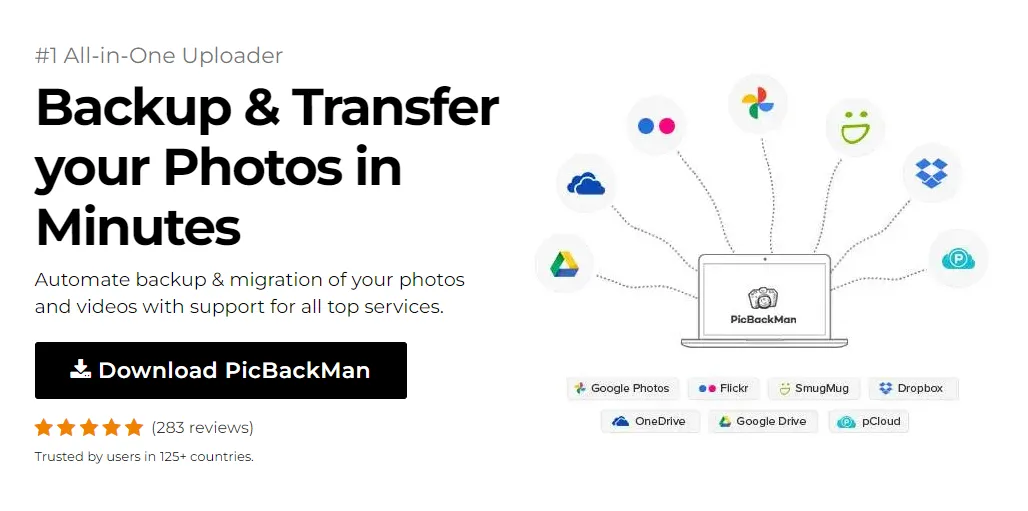What will be the album-structure when photos are migrated from Google Photos to Flickr?
Backup & Transfer your Photos in Minutes
Automate backup & migration of your photos & videos with support for all top services.
Trusted by users in 125+ countries.
In the ever-evolving world of digital photography, many users find themselves considering a switch between photo storage and sharing platforms. One common transition is moving from Google Photos to Flickr. While both services offer robust features for
organizing and sharing your memories, they have distinct approaches to album structures. This article delves into the intricacies of what happens to your carefully curated photo collections when you make the leap from Google Photos to Flickr.
When migrating your photos from Google Photos to Flickr, you'll notice some significant changes in how your albums are organized. Google Photos uses a more flexible and automated approach to album creation, while Flickr adheres to a more traditional,
user-defined album structure.
In Google Photos, you have auto-created albums based on locations, dates, and even facial recognition. These smart features automatically group your photos, making it easy to find specific memories. On the other hand, Flickr relies more heavily on user-created
albums and doesn't offer the same level of automatic organization.
When you transfer your photos, Flickr will maintain the basic album structure you've created in Google Photos. However, any auto-generated albums or smart features will not carry over directly. This means you'll need to reorganize some of your
collections manually once they're in Flickr.
It's important to note that Flickr uses a system of albums and collections. Albums are groups of photos, while collections are groups of albums. This hierarchical structure can be both a blessing and a challenge when migrating from Google Photos,
as it allows for more detailed organization but requires more manual input.
Understanding Google Photos' Album Structure
Before we dive deeper into the migration process, let's take a closer look at how Google Photos organizes your images. This understanding will help you better prepare for the transition to Flickr.
Google Photos employs a combination of user-created albums and AI-driven auto-albums. Here's a breakdown of the main types of albums you'll find in Google Photos:
-
User-created albums: These are the albums you manually create and populate with selected photos.
-
Auto-created albums: Google's AI creates these based on various factors such as location, date, or event.
-
Shared albums: These albums allow multiple users to contribute photos to a single collection.
-
Archive: A special section for photos you want to keep but don't necessarily want in your main photo stream.
-
People & Pets albums: Google Photos uses facial recognition to group photos of specific individuals or pets.
Google Photos also utilizes tags, location data, and date information to help you search and organize your photos without necessarily putting them into specific albums. This flexible system allows for easy retrieval of images based on various criteria.
Flickr's Album and Collection Structure
Now that we've explored Google Photos' organization system, let's examine how Flickr approaches photo organization. Understanding this will give you a clearer picture of what to expect after migrating your photos.
Flickr's organization system is more traditional and user-driven. Here are the key components:
-
Albums: These are similar to Google Photos' user-created albums. They're groups of photos you manually create and organize.
-
Collections: A unique feature of Flickr, collections are groups of albums. They allow for a hierarchical organization of your photos.
-
Galleries: These are curated selections of photos from other Flickr users, allowing you to showcase your favorite images from across the platform.
-
Tags: Similar to Google Photos, Flickr uses tags to help organize and search for photos.
-
Groups: These are community features where users can share photos around a specific theme or topic.
Flickr's structure provides more control over your photo organization but requires more manual input compared to Google Photos' automated features.
The Migration Process: What Stays and What Changes
When you decide to migrate your photos from Google Photos to Flickr, it's crucial to understand what aspects of your current organization will transfer smoothly and what might require additional attention.
What Transfers Smoothly
-
Basic Album Structure: Your manually created albums in Google Photos will generally transfer to Flickr as albums.
-
Photo Metadata: Information such as date taken, camera settings, and GPS data (if available) will typically transfer with your photos.
-
Tags: If you've used tags in Google Photos, these should transfer to Flickr, maintaining some of your organizational structure.
What Requires Attention
-
Auto-Created Albums: Flickr doesn't have an equivalent to Google's auto-created albums. You'll need to manually recreate these if desired.
-
People & Pets Albums: Flickr doesn't offer facial recognition features, so these auto-generated albums won't transfer.
-
Shared Albums: While Flickr allows for sharing, the structure might be different. You'll need to re-establish sharing settings.
-
Collection Structure: Since Google Photos doesn't have an equivalent to Flickr's collections, you'll need to create this organizational layer manually.
-
Archive: Flickr doesn't have a direct equivalent to Google Photos' archive feature. You'll need to decide how to incorporate these photos into your Flickr structure.
Preparing for the Transition
To ensure a smooth transition from Google Photos to Flickr, it's wise to prepare your albums and photos beforehand. Here are some steps you can take:
-
Review Your Google Photos Albums: Go through your albums and identify which ones are user-created and which are auto-generated. This will help you prioritize which albums to recreate manually in Flickr.
-
Plan Your Flickr Structure: Consider how you want to organize your photos in Flickr. Will you use collections? How will you group your albums?
-
Clean Up Your Google Photos: Remove any duplicate or unwanted photos before migrating to avoid transferring unnecessary data.
-
Back Up Your Photos: Always create a backup of your photos before any major migration process.
-
Familiarize Yourself with Flickr: Spend some time exploring Flickr's interface and features to understand how best to organize your photos on the platform.
By taking these preparatory steps, you can make the transition process smoother and ensure that your photos are well-organized in their new home on Flickr.
Tools and Methods for Migration
When it comes to actually moving your photos from Google Photos to Flickr, there are several methods and tools you can use. Here's an overview of some popular options:
Manual Download and Upload
The most straightforward method is to manually download your photos from Google Photos and then upload them to Flickr. While this method gives you complete control, it can be time-consuming for large collections.
Steps:
- Go to Google Takeout and download your Google Photos data.
- Unzip the downloaded files.
- Upload the photos to Flickr using their web interface or desktop uploader.
Third-Party Migration Tools
Several third-party tools can help automate the migration process. These tools can save time, especially for large photo collections. However, be cautious and research any tool thoroughly before using it, as you'll be granting access to your personal
photos.
Some popular tools include:
- PhotoMove
- Cloudinary
- MultCloud
API-Based Solutions
For those with technical skills, both Google Photos and Flickr offer APIs that can be used to create custom migration scripts. This method offers the most flexibility but requires programming knowledge.
Regardless of the method you choose, always ensure you have a backup of your photos before beginning the migration process.
Organizing Your Photos Post-Migration
Once your photos are successfully transferred to Flickr, you'll likely need to spend some time reorganizing them to take full advantage of Flickr's organizational features. Here are some tips to help you get started:
-
Create Collections: Use Flickr's collections feature to group related albums. For example, you might have a "Travel" collection that contains albums from different trips.
-
Use Tags Effectively: Take advantage of Flickr's robust tagging system to make your photos easily searchable.
-
Set Privacy Levels: Flickr allows you to set privacy levels for individual photos, albums, and collections. Review these settings to ensure your photos are shared (or not shared) as you intend.
-
Utilize Flickr Groups: Join relevant Flickr groups to share your photos with like-minded photographers and potentially gain more exposure for your work.
-
Consider Pro Features: If you have a large photo collection, you might want to consider Flickr Pro, which offers unlimited storage and additional organizational tools.
Remember, organizing your photos on Flickr is an ongoing process. As you add new photos and your collection grows, you may need to refine your organizational structure.
Quick Tip to ensure your videos never go missing
Videos are precious memories and all of us never want to ever lose them to hard disk crashes or missing drives. PicBackMan is the easiest and simplest way to keep your videos safely backed up in one or more online accounts. Simply
Download PicBackMan
(it’s free!), register your account, connect to your online store and tell PicBackMan where your videos are – PicBackMan does the rest, automatically. It bulk uploads all
videos and keeps looking for new ones and uploads those too. You don’t have to ever touch it.
Frequently Asked Questions
Will I lose any photos when migrating from Google Photos to Flickr?
If done correctly, you shouldn't lose any photos during the migration process. However, it's always recommended to have a backup of your photos before starting any migration. The actual content of your photos will remain intact, but some organizational
features like auto-created albums may not transfer directly.
Can I keep my Google Photos albums intact when moving to Flickr?
Your manually created albums from Google Photos can be recreated in Flickr, but they won't transfer automatically. Auto-created albums from Google Photos don't have a direct equivalent in Flickr and will need to be manually reorganized.
Does Flickr have a feature similar to Google Photos' facial recognition?
No, Flickr doesn't currently offer facial recognition features like Google Photos does. You'll need to manually organize photos of specific people if that's a feature you frequently use.
What happens to my shared albums when I move from Google Photos to Flickr?
Shared albums don't transfer directly. While Flickr does allow photo sharing, you'll need to set up new sharing arrangements after migrating your photos.
Is there a way to automatically transfer my Google Photos to Flickr?
There's no official automatic transfer tool between Google Photos and Flickr. However, there are third-party tools and services that can help automate the process. Always research these thoroughly before use, as they'll require access to your
photos.
Will my photo metadata (like date taken and location) transfer when I move to
Flickr?
In most cases, yes. Photo metadata like date taken, camera settings, and GPS data (if available) typically transfers with your photos. However, it's always a good idea to check a sample of your photos after migration to ensure all important metadata
has transferred correctly.
Conclusion
Migrating your photo collection from Google Photos to Flickr represents a significant shift in how your digital memories are organized and accessed. While the process may seem daunting at first, understanding the differences between the two platforms
and preparing accordingly can make the transition much smoother.
The album structure when photos are migrated from Google Photos to Flickr will require some manual adjustment, particularly for auto-generated albums and features unique to Google Photos. However, this transition also presents an opportunity to revisit
and potentially improve the organization of your photo collection.
Remember, the goal is not just to transfer your photos, but to ensure they're organized in a way that makes them easily accessible and enjoyable to browse through on your new platform. With some planning and effort, you can create a well-structured
photo library on Flickr that preserves your memories and makes them a joy to revisit.










